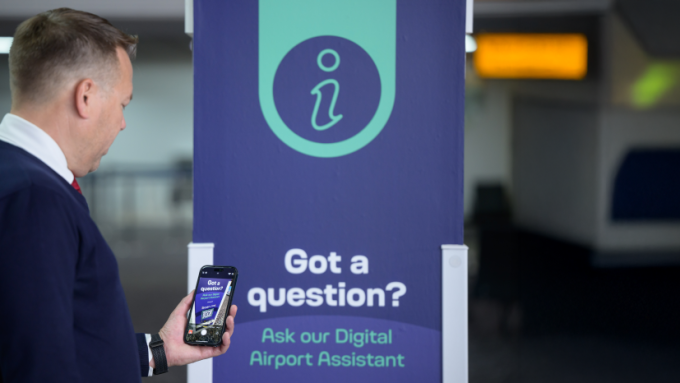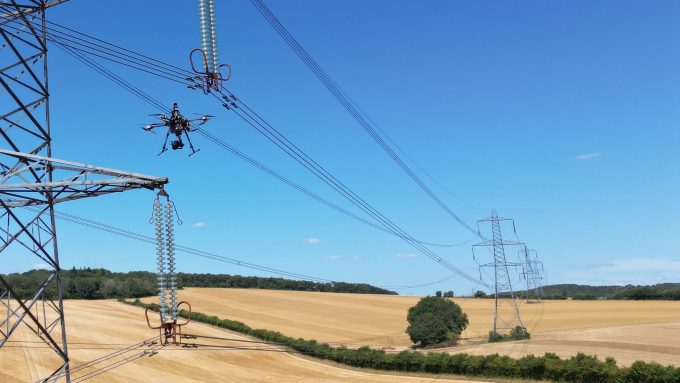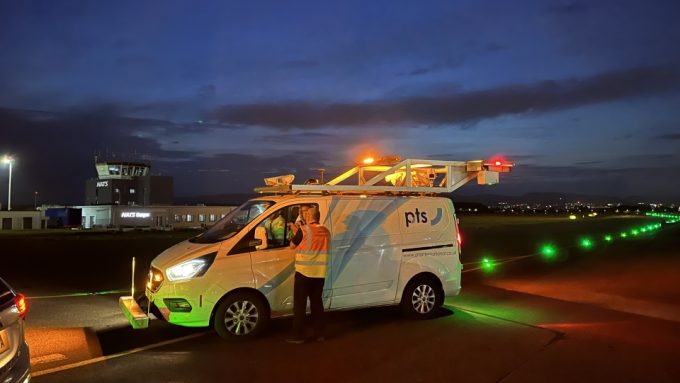
Airport technology trial monitors passenger movements at Glasgow

Demonstration of a digital twin at Glasgow Airport designed to aid passenger flows and reduce traffic congestion has led to discussions about a possible future trial at another airport.
The digital twin created by technology firm Entopy provides predictive intelligence as to how many people will pass through an airport and at what times, and their likely behaviours between arriving on site and the check-in desk.
Providing this sort of advanced analytics is designed to help airport operators plan how best to manage the influx of passengers in the most effective way to ensure their journeys remain smooth.
Use of the digital twin also provides a chance to test the likely impact of any planned upgrades to infrastructure in a virtual environment.

Entopy introduced and trialled its technology for six months at Glasgow after winning a technology competition for small to medium sized companies as part of the Connected Airport Living Lab programme, run by Connected Places Catapult in association with airport operator AGS.
The contest was held to help the operator understand how it might use digital technology to accommodate a large growth in customer numbers – with throughput at the airport expected to double within 15 years.
“One of the major challenges facing the aviation industry is a rising number of passengers each year. Our target objective for the trial was to build a digital twin of passenger movement so the airport could see how passenger growth affected its infrastructure.”Company founder Toby Mills
“This trial provided us with a great opportunity to enter the aviation space and test technology that we previously used to monitor traffic flows in the maritime sector, on the approaches to Dover and Felixstowe.”
Focusing on private car arrivals
Glasgow Airport’s digital twin focused on the 70% of passengers who arrive by road, either in a private car (50%) or taxi (20%). It featured a series of AI micromodels that followed customers through the terminal and considered how many passengers are likely to check-in luggage, before passing through security.
Using historic data, Entopy’s technology predicted the occupancy levels of airport car parks and how many vehicles were about to pass through each car park by hour. The models also showed the time taken to check-in bags and walk through security in 15-minute intervals based on live flight data.
The six-month trial, which was completed in March, aimed to create a ‘baseline’ digital twin model from which simulation capabilities could be developed.
Staff at the airport were provided with access to the software to test the accuracy of the intelligence and provide feedback. A dashboard provided users with information around car park arrivals, passenger check-in numbers and volumes at the security gates each hour.
Users of the software could also adjust the future time intervals on view to provide a snapshot what is likely to happen over the course of the day; with a ‘red, amber, green’ status displaying likely pinch points on a map of key zones across the airport. For the trial, it was found that road traffic time predictions were 94% accurate.
Challenges and an opportunity identified
The trial was not without its challenges, though. The availability of data was identified as a risk to the accuracy of the models – such as from airlines – and access to real-time data was not possible for tracking the arrival of vehicles to the airport, the number of passengers checking-in and passing through security.
Where there was limited data available to train AI micro models, Entopy expanded those datasets with synthetic data, leveraging proprietary technology that it has developed in partnership with the University of Essex. From an operational point of view, engagement with airport staff did not take place until the final month of the trial.
But following meetings with AGS, representatives from another UK airport decided to look at how digital twins could help to monitor passenger flows.
Both Entopy and the airport have found there to be multiple systems already in place to forecast passenger movement at the airport, which could benefit from streamlining into one digital twin. The next step could be a six-month deployment at the second location, subject to trial costs and development of a business case.
Assessment predicts improvements
An impact assessment of the Glasgow trial by Connected Places Catapult found that the digital twin proved to be useful in terms of predicting check-in volumes and processing times through security. If rolled out, it said the digital twin would “contribute to improvements for increased passenger volumes whilst maintaining processing times, increased airside dwell time and retail revenues, and optimised infrastructure expansion”.
Connected Places Catapult’s Senior Technical Consultant, Jonathan Wilson said: “Entopy previously worked with us in maritime and has now demonstrated it can transfer a digital twin model from one industry to another.
“Use of the digital twin and AI micro models allow for a better understanding of passenger movement and for operators to make informed decisions about service provision based on evidence.Connected Places Catapult’s Senior Technical Consultant, Jonathan Wilson
“I was very impressed with the accuracy of their models and how they became more accurate over time. I am pleased we were able to give an SME an opportunity with an airport that they may not otherwise have had.”
Jon Matthews, Transformation Director at AGS Airports, said: "Glasgow Airport’s partnering with Entopy has been a great experience. They understood the specific outcome desires we were seeking to address via their digital twin modelling; to better predict when and where passengers would be arriving and travelling throughout the airport.”
He adds that the trial resulted in some good learning which it is looking to embed into its operation and growth model going forward. “We are highly appreciative of the co-ordination by Connected Places Catapult, who helped select Entopy through an open market review, bringing a number of impressive SMEs to our awareness that we would otherwise not have encountered.”
Read a Meet the Innovator profile from last year about Toby Mills of Entopy.





